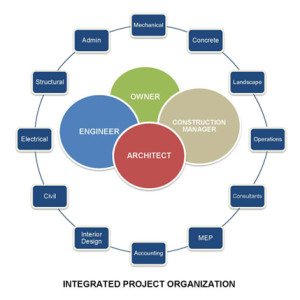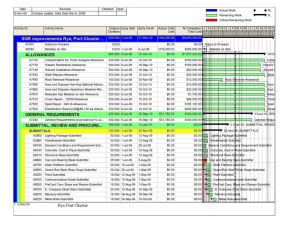This guest post is by construction attorney David Adelstein (photo). David is a Florida Board Certified Construction Attorney with the law firm of Kirwin Norris, P.A. He maintains the website Florida Construction Legal Updates where he blogs about various legal issues that pertain to the construction industry.
Enter David Adelstein:
Strong project management is critical to prime / general contractors in furtherance of ensuring the successful and profitable completion of a project. Among other things, strong project management involves understanding the scope of work activities that drive the timely completion of the project. Having a good plan at the beginning (that is peer reviewed) as detailed in a baseline schedule will enable project management to best coordinate and sequence trades knowing the total float for the project and the float identified for non-critical path trades. The baseline schedule is not written in stone. If it was, it would never need to be updated. But, construction involves unanticipated and unforeseen issues and risks that make it virtually impossible for the baseline schedule to be followed to the tee. No matter the size or complexity of the project, there are always variables that will require the re-sequencing of activities (and their start and finish dates) that will push different activities on and off the critical path. The more complex the project the more likely there will be variables that a strong project management team will need to address and work through.
One way project management can be proactive is to have a scheduling consultant on the front end. The consultant can be used in numerous roles including preparing the baseline schedule with the input from the contractor’s project management and subcontractors regarding the appropriate duration for activities. The consultant can assist in a peer review capacity to understand the scheduling plan and perform an objective check of the schedule. Or, the consultant can be used to assist in updating the schedule once the project gets going and variables are encountered. As the idiom goes, “An ounce of prevention is worth a pound of cure.” Utilizing the appropriate assistance to ensure (i) a good plan is in place from the get-go, (ii) that the plan is actually implemented and followed, and (iii) that there are plans in place when variables are encountered, is worth it instead of trying to deal with a bad plan after-the-fact or a good plan that is never actually implemented.
When consultants get involved, they will want to know and understand the project’s critical path. If the consultant gets involved on the front-end, they can assist in determining the critical path based on the project management’s plan. If they get involved after-the-fact, they will want to understand the plan by tracking the baseline schedule with updates that reflect as-built conditions. This will help determine where time impacts / delays occurred. The consultant can then take this information as to those activities that impacted the critical path to figure out why. Was there a bad plan from the get-go? Was there a good plan that was never actually implemented and followed? Were there design errors and omissions that resulted in numerous RFIs, supplemental instructions, or revisions to the plans? Were there numerous changes, whether owner-directed or due to design errors and omissions? Did a trade subcontractor simply struggle with quality control or sticking to durations? These are all issues that will be analyzed in connection with the schedules to best determine why time impacts occurred. Now, when the consultant gets involved after-the-fact, there is a little recreating of history (or revisionist history) since the consultant needs to reinterpret events and schedules after they already occurred. However, if the consultant is utilized from the get-go, hopefully, the time schedule impacts and documentation / evidence is being reviewed and organized to best capture the time impacts. This is valuable because it will allow project management to timely notify the owner of the time impacts and the appropriate extension of time and additional compensation to request. (Keep in mind that most contracts provide that a failure to timely notify the owner results in a waiver of the additional time or cost.) This is also valuable, as explained above, to best determine how to update the schedule and potentially re-sequence scope of work activities and coordinate the trades.
The critical path becomes a very important issue when the project is not going to be completed by the original substantial completion date. Because contracts allow the owner to assess liquidated damages due to delays (or actual damages if there is not a liquidated damages provision), the contractor will need to prove that any delays to the critical path are not its fault, not only to offset any assessment of liquidated damages, but also to establish an affirmative entitlement to extended general conditions. This is why the contractor will want to timely submit a claim for time impacts that include an appropriate amount of time to rebound from the impact. Also, in the event time impacts were in fact caused by the contractor, it will want to know which trade subcontractors contributed to the impact in order to flow down liquidated damages and its own extended general conditions.
Typically, contractors have the burden in proving delays attributable to the owner which will require it to establish the critical path. See Daewoo Engineering and Const. Co., Ltd. v. U.S., 73 Fed.Cl. 547 (Fed.Cl. 2006); accord George Sollitt Const. Co. v. U.S., 64 Fed.Cl. 229 (Fed.Cl. 2005); Morrison Knudsen Corp. v. Fireman’s Fund Ins. Co., 175 F.3d 1221 (10th Cir. 1999); U.S. Fidelity & Guar. Co. v. Orlando Utilities Com’n, 564 F.Supp. 962 (M.D.Fla. 1983). This type of proof will require a witness–really, an expert witness–that understands scheduling and the software used to develop the schedules to explain the critical path and the impacts to the critical path of the project. This will require testimony of the baseline schedule or plan along with the as-built conditions. Without this proof, the contractor is not going to be able to specifically prove that the delay(s) to the substantial completion date was caused by the owner and its consultants. The proof should entail the witness proving the time period in which the impact occurred and the issues that caused this impact (i.e., design error or omission, delay in design professional responding to RFI, design revisions, change order work, etc.). The same burden will be required when the contractor tries to flow down liquidated damages or seek its extended general conditions from a subcontractor that caused the time impacts.
Time impacts, however, cannot be perceived in a vacuum. In other words, time impacts are not always so clean that one discrete issue undeniably caused the delay. Because there are many activities taking place at the same time and many balls being juggled during the course of construction, oftentimes multiple issues that occurred around the same time period need to be analyzed. The reason for this is to determine whether there was a concurrent delay where both parties to the dispute (whether owner verses contractor or contractor verses subcontractor) contributed to the same delay time period, and thus, neither should recover from the other. “The doctrine of concurrent delay involves the premise that where both parties to the litigation caused delays then neither party can recover damages for that period of time when both parties were at fault.” Broward County v. Russell, Inc., 589 So.2d 983, 984 (Fla. 4th DCA 1991); accord Blinderman Const. Co., Inc. v. U.S., 695 F.2d 552 (Fed.Cir. 1982). Hence, if there is a concurrent delay, neither party will be able to recover (which, sometimes, this is what a contractor is seeking to simply offset liquidated damages exposure) unless the contractor can apportion the delay attributable to each party during the concurrent delay time period. See George Sollitt Const. Co. v. U.S., 64 Fed.Cl. 229 (Fed.Cl. 2005); accord Smith v. U.S., 34 Fed.Cl. 313 (Fed.Cl. 1995); William F. Klingensmith, Inc. v. U.S., 731 F.2d 805 (Fed.Cir. 1984).
There is much more to critical path scheduling and proving delays then discussed here. The bottom line is having strong project management requires an understanding of scheduling or utilizing the appropriate scheduling consultant to best achieve the successful and profitable completion of a project.
David Adelstein practices construction law throughout the Southeast. He has represented contractors, subcontractors, design professionals, developers, associations, suppliers, sureties, and owners in a myriad of construction matters including, without limitation, construction / design defect claims, schedule-based claims (including inefficiency, lost productivity, and acceleration claims), bid protests, payment disputes, lien and bond claims, liability and property insurance issues, and a host of other issues that affect the construction industry. He can be reached as follows:
Website: http://www.floridaconstructionlegalupdates.com/
Address: Kirwin Norris, P.A.
110 East Broward Boulevard, Suite 1570
Fort Lauderdale, Florida 33301
Email: dma@kirwinnorris.com
Phone: (954) 759-0026
Fax : (954) 759-0028






